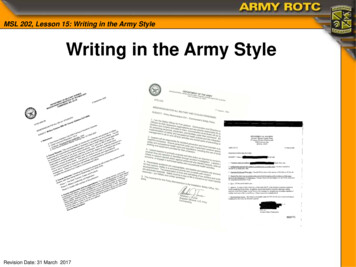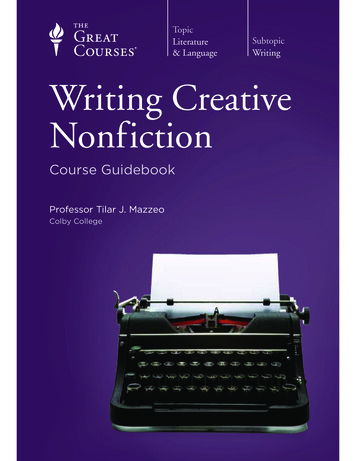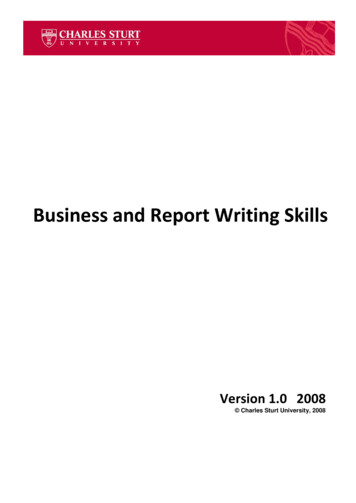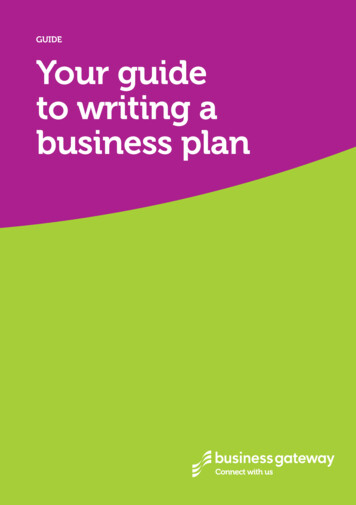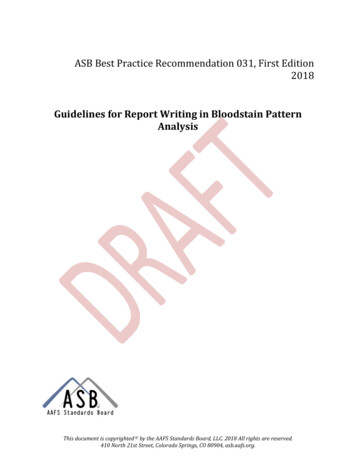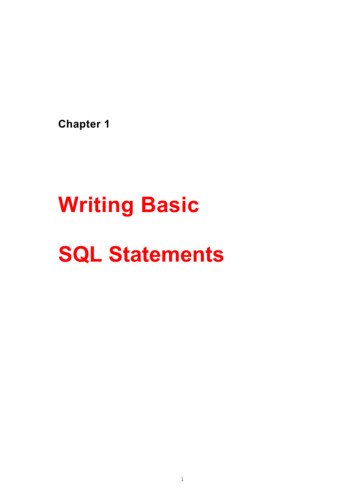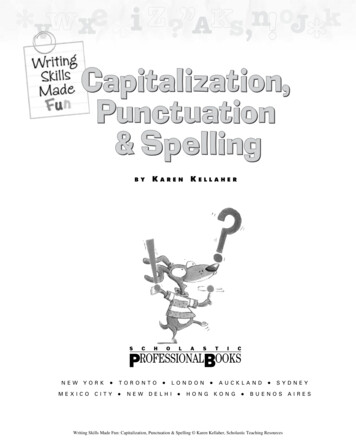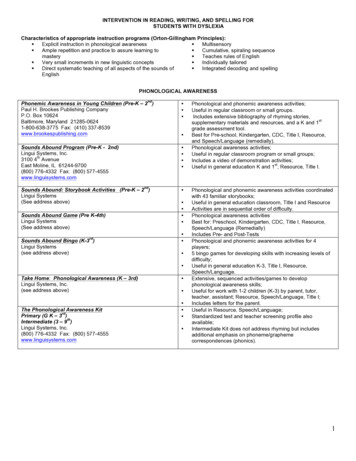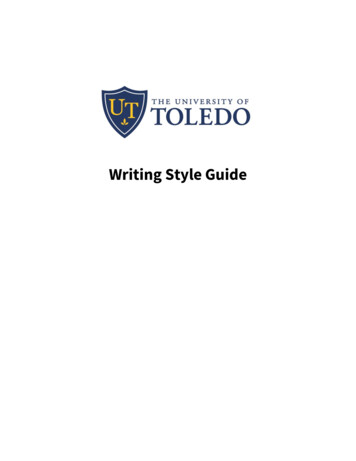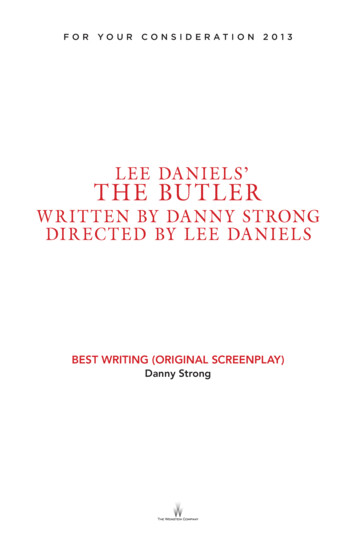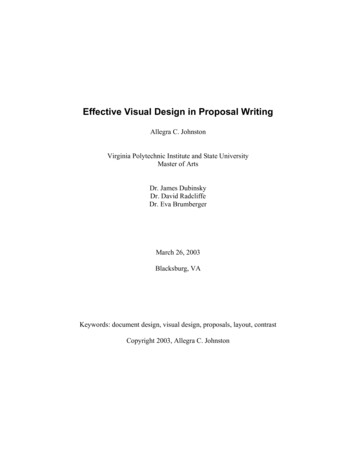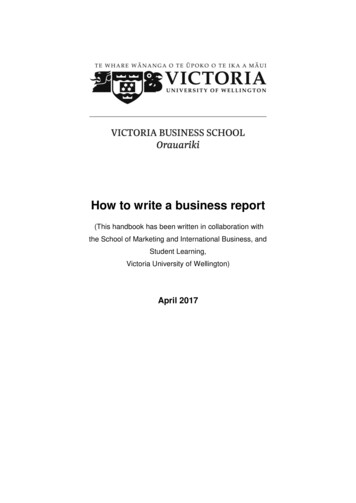
Transcription
How to write a business report(This handbook has been written in collaboration withthe School of Marketing and International Business, andStudent Learning,Victoria University of Wellington)April 2017
ContentsIntroduction . 11 Planning your business report. 21.1 What is the purpose of this report? . 21.2 Who are the readers of this report? . 21.3 What are the report’s main messages?. 31.4 How will the messages be structured? . 32 Structuring your business report . 42.1 Covering letter/memorandum . 42.2 Title Page . 52.3 Executive Summary . 52.4 Table of Contents . 52.5 Introduction . 62.6 Conclusions/recommendations . 62.7 Findings and discussion . 82.8 References. 82.9 Appendices . 83 Writing your business report . 103.1 Use effective headings and subheadings. 103.2 Structure your paragraphs well . 113.3 Write clear sentences with plain language . 123.4 Keep your writing professional . 133.5 Use white space and well-chosen fonts . 143.6 Number your pages. 153.7 Use footnotes, tables, figures, and appendices appropriately . 15i
4 Concluding remarks . 17References. 18Appendix A: Checklist of a business report . 19Appendix B: Linking ideas within sentences and paragraphs . 20Appendix C: Specific report requirements . 21Appendix D: An example of a finished report . 23ii
IntroductionWriting an effective business report is a necessary skill for communicatingideas in the business environment. Reports usually address a specific issue orproblem, and are often commissioned when a decision needs to be made.They present the author’s findings in relation to the issue or problem and thenrecommend a course of action for the organisation to take. The key to a goodreport is in-depth analysis. Good writers will show their reader how they haveinterpreted their findings. The reader will understand the basis on which theconclusions are drawn as well as the rationale for the recommendations.Report writing uses some of the writing skills you have already acquired. Youwill structure your paragraphs and reference your ideas just as you have beendoing in your essays and other assignments within your Commerce degree.You might want to refer to the Victoria Business School Writing SkillsWorkbook you received in the first year. Report writing sometimes differs instructure and style. This handbook will help you plan, structure, and write abasic report. Remember, though, that reports will vary according to theirpurpose and the needs of their reader/s. Throughout your university career,different courses and/or different lecturers may have slightly differentrequirements for reports. Please always check the requirements for eachassignment.AcknowledgementWe acknowledge Write Limited, New Zealand’s plain English specialists.Many of their principles for good business writing are reflected in thishandbook. A reference to their style guide is found in the reference list on p17.1
1 Planning your business reportAs in all writing, planning is vitally important. The key questions to ask yourselfwhen planning a business report are: what is the purpose of this report who are the readers of this report what are the report’s main messages how will the report be structured?1.1 What is the purpose of this report?Keep in mind that the purpose of a business report is generally to assist indecision making. Be sure you are clear on what decision is to be made andthe role the report plays in this decision. It might be useful to consider thepurpose in this way: As a result of this report, my reader/s will For example:As a result of this report, my reader/s will know:-how well our recycling programme is doing-how to increase participation in it.1.2 Who are the readers of this report?Consider the main reader/s, but also secondary readers. The main reader forthe recycling report alluded to above is the director of the recyclingprogramme. Secondary readers might be the facilities management team oncampus, the finance team, etc.Try to understand what the readers already know, what they need to know,and how they will use this report. You will need to give enough information tosatisfy all these potential readers. You will need to use headings carefully sothat different readers can use the report in different ways.2
1.3 What are the report’s main messages? Taking into account the information above, think carefully about themain message/s you need to convey, and therefore what information isrequired. Ask yourself: What are the required pieces of information Ineed to include? What are the additional pieces of information I need to include?1.4 How will the messages be structured?The modern business approach is direct (or deductive, to use a moresophisticated term). This approach presents the conclusions orrecommendations near the beginning of the report, and the report providesjustification for these recommendations. This approach will be used for theremainder of this handbook and for report writing in general in the VictoriaBusiness School (Commerce Faculty).It should be noted, however, that there is sometimes a place for the indirect(inductive) approach. This approach leads the reader through the discussionfirst and reveals the conclusions and recommendations at the end of thereport. This approach might be used if the recommendations are likely to becontroversial or unpopular (Emerson, 1995).The next step is to construct an outline, or structure, for your report. Checkfor a logical flow, and check your outline against your purpose, your reader/s,and the report’s relevant information requirements.3
2 Structuring your business reportA business report may contain: a covering letter or memorandum a title page an executive summary a table of contents an introduction conclusions recommendations findings and discussion a list of references appendices.2.1 Covering letter/memorandumOften a letter is attached to a report to officially introduce the report to therecipient. If the recipient is outside the organisation, a letter format isappropriate; if the recipient is inside the organisation, a memorandum/memois appropriate.The covering letter or memorandum should: remind the reader of their request for the report state the purpose of the report acknowledge any assistance indicate future actions to be taken.4
2.2 Title PageThe title page should be brief but descriptive of the project. It should alsoinclude the date of completion/submission of the report, the author/s, and theirassociation/organisation.2.3 Executive SummaryThe executive summary follows the title page, and should make sense on itsown. The executive summary helps the reader quickly grasp the report’spurpose, conclusions, and key recommendations. You may think of this assomething the busy executive might read to get a feel for your report and itsfinal conclusions. The executive summary should be no longer than one page.The executive summary differs from an abstract in that it provides the keyrecommendations and conclusions, rather than a summary of the document.2.4 Table of ContentsThe table of contents follows the executive summary on a new page. It statesthe pages for various sections. The reader receives a clear orientation to thereport as the table of contents lists all the headings and sub-headings in thereport. These headings and sub-headings should be descriptive of the contentthey relate to (see section 3 of this handbook).5
2.5 IntroductionThe introduction sets the stage for the reader. It gives the context for thereport and generates the reader’s interest. It orients the reader to the purposeof the report and gives them a clear indication of what they can expect.The introduction should: briefly describe the context identify the general subject matter describe the issue or problem to be reported on state the specific questions the report answers outline the scope of the report (extent of investigation) preview the report structure comment on the limitations of the report and anyassumptions made.(Adapted from Emerson, 1995, p. 35)2.6 Conclusions/recommendationsA business report usually needs both conclusions and recommendations. Thedifference between conclusions and recommendations in a report lies in theorientation to time. Conclusions typically relate to the present or pastsituation.When writing conclusions: interpret and summarise the findings; say what they mean relate the conclusions to the report issue/problem limit the conclusions to the data presented; do not introducenew material number the conclusions and present them in parallel form be objective: avoid exaggerating or manipulating the data.(Guffey, Rhodes & Rogin, 2001, p. 391)6
Recommendations are oriented to the future: what changes arerecommended, or what actions are recommended for the future? They arespecific, action-oriented suggestions to solve the report problem.When writing recommendations: make specific suggestions for actions to solve the report problem avoid conditional words such as maybe and perhaps present each suggestion separately and begin with a verb number the recommendations describe how the recommendations may be implemented (if you wererequested to do this) arrange the recommendations in an announced order, such as mostimportant to least important.(Guffey, et al. 2001, p. 392)Although the conclusions and recommendations are presented before thediscussion, they need to logically flow from the discussion. Taking a deductiveapproach allows the reader insight into your conclusions/recommendationsearly on. When your reader reads the discussion afterwards, they will follow itmore easily. Here are some examples of conclusions and recommendations:ConclusionsRecommendationsHome and family responsibilities directlyaffect job attendance and performance.Provide managers with training in workingwith personal and family matters.Time is the crucial issue to balancingwork and family income.Institute a flexitime policy that allowsemployees to adapt their work scheduleto home responsibilities.A manager supportive of family andpersonal concerns is central to a goodwork environment.Publish a quarterly employee newsletterdevoted to family and child-care issues.(Adapted from Guffey, et al. 2001, p. 391-392)7
2.7 Findings and discussionThe discussion is the main part of your report and should present and discussyour findings. It should give enough information, analysis, and evidence tosupport your conclusions, and it should provide justification for yourrecommendations. Its organisation will depend on your purpose, scope, andrequirements, but it should follow a logical and systematic organisation. Thediscussion should be subdivided into logical sections, each with informative,descriptive headings and a number.Where your report’s purpose is to recommend the best solution to a problem,you should show clear analysis of all options. You should explain anyanalytical framework you used, such as SWOT or cost benefit analysis. Thisanalysis of options can often be presented effectively in tables.2.8 ReferencesWhenever you use information from other sources, references must beprovided in-text and in a list of references. The style of referencing may bedictated by your faculty or organisation. The Faculty of Commerce at Victoriauses APA. See the Victoria Business School Writing Skills Workbook (that youwere given in first year in the FCOM 111 course) for information on APAreferencing or see the APA manual (APA, 2010). You can download a copy ofthe Writing Skills Workbook from the VBS website.2.9 AppendicesIf material is important to your discussion and is directly referred to, then itshould be included in your discussion proper. However, you might want to useappendices to include supplementary material that enhances understandingfor the reader. You might use appendices to provide details on the process oranalysis you underwent (or which was required by your supervisor or lecturer).8
When you choose to include information in appendices, you should refer to itclearly in your text (refer Appendix A). A single appendix should be titledAPPENDIX. Multiple appendices are titled APPENDIX A, APPENDIX B, etc.Appendices appear in the order that they are mentioned in the text of thereport.Appendices should: provide detailed explanation serving the needs ofspecific readers be clearly and neatly set out be numbered/lettered be given a descriptive title be arranged in the order they are mentioned in the text be related to the report’s purpose—not just ‘tacked on’.(Adapted from Emerson, 1995, p. 41)A checklist of elements of a good business report is provided in Appendix A.9
3 Writing your business reportNow that you have organised your thoughts, you need to put them into writing.Ensure your writing demonstrates clarity and logic. You should thinkconstantly about your readers and make your report easy for them to read. Toachieve good readability, you should: use effective headings and subheadings structure your paragraphs well write clear sentences with plain language keep your writing professional use white space and well-chosen fonts number your pages use footnotes, tables, figures, and appendices appropriately.3.1 Use effective headings and subheadingsHeadings and subheadings are useful tools in business writing. Ensure theyare descriptive of the content to follow. In other words, rather than labelling asection Section 2.5, it would be better to describe it as 2.5 Justification forthe high risk scenario. It is also essential that the hierarchy of headings andsubheadings is clear. Use formatting (font size, bold, etc.) to show headingsversus subheadings. Headings/subheadings at the same level should useparallel form (the same grammatical construction). The following examplesillustrate this principle.Ineffective headings with nonparallel constructionEffective headings with parallelconstructionEstablishing formal salesorganisationEstablish formal sales organisationProduction departmentresponsibilitiesDefine responsibilities within theproduction departmentImprove cost-accountingImprove cost accounting(Adapted from Munter, 1997, p. 53)10
Use sentence case for headings. This means that your first word shouldhave a capital letter, but subsequent words have small letters, unless, ofcourse, they are proper nouns (Write Limited, 2013). Remember toensure that all material placed underneath a heading serves that heading.It is easy to go off on a tangent that does not relate to a heading.Remember also that all content must relate to your purpose. Every timeyou write a new section of your report, check that it fulfils the purpose ofthe report.3.2 Structure your paragraphs wellYour headings will help create logical flow for your reader, but under eachheading, you should create a series of paragraphs that are also logicallyordered and structured. Paragraphs should be ordered in a logical sequencebeginning with the most important material first. Within your paragraphs youshould also use a structure that helps your reader. Each paragraph shouldbegin with a topic sentence that states the main idea or topic of theparagraph. Typically a paragraph will have between 100 and 200 words andwill have the following structure. Topic sentence (states main idea of paragraph) Explanation sentence (explains or expands on the topic sentence) Support sentences (give evidence for the idea in the topic sentenceand include statistics, examples, and citations) Concluding sentence (optional final sentence that answers the question‘so what?’; this is your opportunity to show your critical thinking ability)Remember to link your paragraphs well. The first sentence (usually the topicsentence) is a good place to make a link between paragraphs. One of themost common ways to link paragraphs is to use the principle, ‘something old,something new’. This means you will include a word or phrase that contrasts11
the topic of the previous paragraph with the topic of your new paragraph. Takea look at the topic sentence at the beginning of this section 3.2. You will seethat this topic sentence links to the material before it. For an example showinghow to link ideas in a paragraph using the ‘something old, something new’principle, see Appendix B.3.3 Write clear sentences with plain languageAcademic and business writing should be clear. You want to clearlycommunicate your understanding of the topic and the strength of yourargument. In order to do this, keep your sentences short and use plainlanguage where you can (Write Limited, 2013). Sentences that are too longand complicated are difficult to understand. A good average length is 15–20words (roughly 1.5 lines). Try not to go over 2 lines. Sometimes students try touse big words in order to sound academic. This is not always a good idea. Ifyou need a big (sometimes technical) word, fine. However, if a shorter onedoes the job, use it. For example, use is better than utilise, and change isbetter than modification.Look at the following example.Phase one of the project included the collection of a range of data andresearch material completed during 2011, which was utilised in the creation ofa range of soon to be finalised analyst ‘personas’, and input into the planningof a new enhanced information architecture for the business’s online channel,particularly resources for current analysts.Now look at a plainer version.In 2011, the team undertook phase one of the project. They collected a rangeof data and research material. Using this collected material, they createdanalyst ‘personas’. They also began to plan an enhanced informationarchitecture for the business’s online channel. Current analysts can use someof the resources the team have created.12
You will notice some of the sophisticated words have changed to plainer ones.You will also notice that the sentences are shorter and easier to understand.Another change relates to ‘active voice’. You will notice that the first exampleuses some ‘passive voice’: which was utilised. Passive voice enables writersto omit the people (or doers) from their sentences. However, readers oftenappreciate knowing ‘who’ does something. You will notice in the secondexample, the writer adds a doer: team. This means the writer can now use theactive voice: In 2011, the team completed All of these techniques—shortsentences, plainer language, and active voice—will help your readerunderstand your message in one reading. This is especially important inbusiness writing where readers have busy working days.3.4 Keep your writing professionalEnsure you use an appropriate tone for your readers. Where possible, usepersonal pronouns we and you: We recommend you check the building’sfoundations. Personal pronouns create a friendly tone that is appropriate forNew Zealand business and government. They also help the writer avoid thepassive voice. And, as stated above, readers like to know ‘who’ will dosomething. However, sometimes you might want a more formal tone wherepersonal pronouns are not appropriate. In these cases, you can use wordslike research or report as your sentence subject: This report discusses , Thisresearch has found that . Another way of ensuring appropriate tone is toavoid terms that may be interpreted as offensive to ethnic or other groups. Becareful to use gender-neutral terms. For example, use plural pronouns (theywhen referring to clients) rather than gender-specific pronouns (he or he/she).Another aspect of tone relates to the use of contractions. Contractions arewords like we’ve or it’s. They are informal. For many business reports and forall academic reports, you will need to avoid them and write we have or it is.Other important characteristics of professional writing are editing andproofreading. You should leave 24 hours between writing your draft andediting it. You should also leave another 24 hours between editing andproofreading. Leaving time between these stages of the writing process allows13
you to detach yourself from your writing and put yourself in your reader’sshoes. When editing, check for: illogical structure missing headings irrelevant or missing content unnecessary content redundant phrases or words.When proofreading, check for: grammar punctuation spelling formatting consistency.Remember to leave enough time for these last two stages. Thorough editingand proofreading will make a big difference to the readability of your report (aswell as to your marks!), and it is a courtesy to the reader.3.5 Use white space and well-chosen fontsWhite space refers to the empty space on the page. Business reports whichhave a more balanced use of white space and text are easier to read andmore effectively communicate main points and subordinate ideas. Createwhite space by: using lots of headings and subheadings creating large margins along all edges (usually 2.5–3cm) breaking up your page with tables, charts, and graphs where possible using bulleted lists.14
3.6 Number your pagesYour title page has no number. Use Roman numerals for the executivesummary and table of contents (i, ii, iii), and Arabic numbers for the remainderof the report (1, 2, 3 ).3.7 Use footnotes, tables, figures, and appendices appropriatelyFootnotes should be used sparingly. Points that are important can usually beintegrated into the text. Footnotes or endnotes should not be used forreferencing (see References above).In business reports, tables and figures are often used to represent data,processes, etc. Tables and figures should be inserted in the text of thedocument, close to the discussion of the table/figure. If the information issomething which the reader could refer to rather than should refer to, then itmay go in the appendices. Tables and figures have different purposes. A tablecontains an array of numbers or text (such as a SWOT table). A figure issomething that contains graphical content, such as graphs created in Excel,organisational charts, or flow charts.Insert each table/figure one-and-a-half or two lines below the text. Thetable/figure should be identified with a label and title which describes thecontent, for example, Table 1. GDP of New Zealand, 1988–2002.If a table, figure, or appendix is included in a document, then there must betext that refers to it! The text should refer to it by name (As Table 1shows .). The text should explain the highlights of the table or figure, notevery detail. Do not leave it to the reader to try to figure out why you includedthe table or figure in your document. At the same time, ensure that yourtables/figures supplement and clarify the text but do not completely duplicateit. Also ensure that there is sufficient information in the table or figure so thatthe reader can understand it without having to consult the text.15
Footnotes immediately underneath the table or figure should be used toexplain all abbreviations and symbols used. Do not forget to add the source ofyour material.16
4 Concluding remarksNow that you have the tools to develop your report, your communicationshould be more efficient and effective. Individual schools may have specificrequirements for your report, so check with your course coordinators in casethey have specific requirements. For example, the School of Marketing andInternational Business provides the guide attached in Appendix C. A samplereport for general business writing is provided in Appendix D.Don’t forget to make use of the resources at Student Learning should yourequire more guidance. Happy writing!17
ReferencesAPA. (2010). Publication manual of the American Psychological Association(6th ed.). Washington, DC: American Psychological Association.Emerson, L. (Ed.) (1995). Writing guidelines for business students.Palmerston North: The Dunmore Press.Guffey, M. E., Rhodes, K., & Rogin, P. (2001). Business communication:Process and product (3rd Canadian ed.). Scarborough, Ontario: NelsonThomson Learning.Munter, M. (1997). Guide to managerial communication: Effective businesswriting and speaking (4th ed.). Upper Saddle River, NJ: Prentice Hall.Write Limited, (2013). The Write Style Guide for New Zealanders: A manualfor business editing. Wellington, New Zealand: Write Limited.18
Appendix A: Checklist of a business report The report fulfils its purpose The report is oriented to the intended reader/s The report contains all appropriate elements (executive summary, tableof contents ) The discussion has descriptive and appropriately formatted headingsand subheadings The discussion contains thorough analysis of findings as well as logicalflow The report has been edited for section cohesiveness and goodparagraph structure The report has been proofread for sentence structure, spelling,punctuation, and consistency Tables and figures are formatted correctly and labelled Tables, figures, and appendices are referred to within the text /discussion Quotations from other sources are referenced Thoughts and ideas paraphrased from other sources are referenced The reference list is formatted properly The cover page has all necessary details Appendices are used to support the discussion, but tables / figureswhich are essential to the discussion are included within the text19
Appendix B: Linking ideas within sentences and paragraphs When structuring sentences, the subject and verb should occur as closelytogether as possible. For example, The PLC is important, not The PLC,which has been around a long time, and has seen wide use, in manycontexts, continents, industries, product categories, and so forth, isimportant. Place the material you want to emphasize at the stress position in thesentence. In a short sentence, the stress position is usually at the end ofthe sentence. You want to emphasize new material. For example,assuming you have already introduced the PLC, and the point you want tomake next is that it is important, you would write, The PLC is important,rather than, An important concept is the PLC. In the above illustration, when you start the paragraph with the sentence,The PLC is important, you have accomplished two things. First, you havemade the point that the purpose of the paragraph is to argue that the PLCis important. Second, the notion that it is important is no longer newinformation. Subsequent sentences should provide new information thatsupports that point. The next sentence, for example, might be:It is important because it explains why firms must develop new products;or:It is important for three reasons. The first reason is .; or:It is important for many reasons. One important reason is .Note that the stressed part of the previous sentence is no longer new andhas been moved to the front of the current sentence. The new informationin the current sentence is a reason why the PLC is important. The reasonis placed in the stress position. The same pattern applies to the following sentences: The PLC isimportant. It is important because it explains why firms must develop newproducts. New products must be developed because competitors enter thefirm’s markets, offerings become more homogeneous, prices decrease,and margins are reduced.20
Appendix C: Specific report requirementsFor all reports, be sure that you adhere to the requirements of your particularorganisation. In New Zealand business and government, these requirementswill usually be stated in your organisation’s style guide. A style guide is ahandbook telling writers which conventions of grammar, punctuation, and toneto follow. It also tells writers how to format their documents. At Victoria, youshould adhere to your particular course and/or school requirements.Specific requirements for most reports submitted in the School forMarketing & International Business (SMIB)1. Answer the questionThe most important requirement is to answer the question! Be sure to readyour assignment question very carefully.2. Structure your report effectively[Title of your report/project]Use this handbook to guide your structure.The key parts of your reports will be: title page (follow the t
Writing an effective business report is a necessary skill for communicating ideas in the business environment. Reports usually address a specific issue or problem, and are often commissioned when a decision needs to be made. They present the autho
